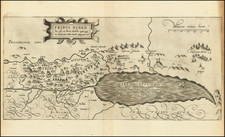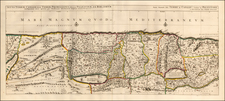Striking image of Moses at the bottom of Mt. Sinai, with the smashed tablets of the law at his feet, watching the children of Israel worship the golden calf.
The German text translates as follows:
At this time, the children of Israel made for themselves a molten calf in the manner of the Egyptians (who worshiped their king Apis). For while Moses tarried with the Lord on the mountain, the people spoke to Aaron and demanded that he make for them gods to worship and to go before them. And when Aaron resisted them, they threatened him (as the story goes) with spears. Out of fear, Aaron said, 'Take the golden jewelry of your wives and children.' Once they had given these to him, he fashioned a molten calf from them. And the people declared, 'These are your gods, O Israel, that have brought you out of the land of Egypt.' And Aaron built an altar and declared a feast for the next day. They rose up early and made sacrifices and the people sat down to eat and drink, and rose up to play (that is, to worship).
The Lord then said to Moses, 'Go down; your people have committed idolatry. Let me destroy them.' But Moses replied, 'Lord, I beg you, restrain your anger, lest the Egyptians say he deceitfully brought them out to kill them in the mountains and wipe them from the face of the earth.' When the Lord relented, Moses descended and carried with him stone tablets written with the finger of God. Joshua ran to meet him and said, 'There's the noise of war in the camp.' But Moses replied, 'It's the sound of singing.' And when he came closer, he saw the calf and the dancing, and he was angry and threw the tablets down, breaking them. After hearing Aaron's defense and explanation regarding the creation of the calf, Moses burned it, ground it to powder, scattered it on water, and made the Israelites drink it. The same powder appeared on the beards of those who had worshiped the calf. He then commanded the Levites to take their swords and to kill all those marked with the powder. Many thousands died that day.
On the verso are images of the the creation of the "Table for the Bread of Faces" or "Table for the Bread of the Presence." This is the Acacia wood table created following the burning of the Golden Calf. The table itself had a specific function. It held the "Showbread" or "Bread of the Presence," which consisted of twelve loaves, representing the twelve tribes of Israel. These loaves were always present in the Tabernacle and were replaced with fresh bread weekly.
The german text below translates as follows:
At that time, the Israelites made a molten calf in the Egyptian manner. While Moses lingered on the mountain with the Lord, the people told Aaron to craft gods for them. Out of fear, Aaron fashioned a golden calf from their jewelry. They declared this to be the god that led them from Egypt. Aaron made an altar and a feast was announced. They indulged in revelry. The Lord told Moses of their idolatry and wanted to destroy them, but Moses pleaded for mercy, reminding God of His promises. When Moses descended and saw the idolatry, he broke the stone tablets. After Aaron explained, Moses destroyed the calf, made it into a powder, and made the Israelites consume it. Many were killed that day due to their transgressions.
Separately, God instructed Moses to craft a table from acacia wood, overlaid with gold. The table stood on four feet, each with golden rings and poles for carrying. The table had a moulding, half on top and half hanging below for decoration. Twelve unleavened bread loaves, symbolizing the tribes of Israel, were placed on it - six on the right and six on the left. Alongside each was a golden dish of incense. Fresh bread was set out every Sabbath. Only priests ate this bread, known as the Showbread. This act was a perpetual reminder for the Israelites.
The Liber Chronicarum, or Nuremberg Chronicle, is a universal history, with a strong emphasis on geography, also known as a cosmography. The work was published by Anton Koberger on a commission from the merchants Sebald Schreyer and Sebastian Kammermeister. At this time Koberger, the second printer to set up shop in Nuremberg, was at the height of his business, with as many as eighteen presses at work.
For the compilation of the Latin text, which was translated into the vernacular by George Alt, Schedel called on Medieval and Renaissance writers including Bede, Vincent of Beauvais, Martin of Tropau, Flavio Biondo, Bartolomeo Platina, Aeneas Piccolomini, and Jacobus Philippus Foresti de Bergamo. Schedel split the book into parts: Creation, the ages of Adam, Noah, Abraham, and David, the Babylonian Captivity, the life of Christ, the Antichrist, and Judgement Day, followed by a text on Poland, on Europe, and all with a final note on how the book was made. The work contains 1,804 woodcut images executed from 641-3 woodblocks by Michael Wohlgemut (1434-1519) and his stepson Wilhelm Pleydenwurff (1460-1494). Interestingly, Albrecht Durer had worked and learned in the Wohlgemut shop in the late 1480s and Koberger was his godfather.
The Chronicle appeared in 1493, with the first print run taking place between March 16, 1492 and June 12, 1493, for the Latin edition, and to December 23, 1493, for the German translation. A reduced-size (quarto) version of the book, with new illustrations, was published in several editions by Johann Schonsperger, in Augsburg, between 1496 and 1500.
The encyclopedic book includes many portraits and illustrated scenes, including the famous Dance of Death. The geographic content of the Chronicle is also notable. In addition to the double-page Ptolemaic world map and a map of Northern Europe, there are large format views of many cities including Rome, Venice, Paris, Vienna, Florence, Genoa, Salzburg, Krakow, Breslau, Budapest, Prague, Jerusalem, Alexandria, Constantinople, as well as a number of towns in what would become the German Empire.
Hartmann Schedel (1440-1514) was a physician, book collector, and writer whose most famous work, the Liber Chronicarum (Nuremberg Chronicle), included some of the first printed views of many cities in Europe and across the world.
Schedel was born and died in Nuremberg, but he also traveled for his education. From 1456 to 1463 he lived in Leipzig, where he attended the University of Leipzig and earned his MA. From there he went to Padua, where he earned a Doctor of Medicine in 1466. After university, he worked for a time in Nördlingen and then returned to Nuremberg. In 1482 he was elected a member of the Great Council of Nuremberg.
The Chronicle was published in 1493. Besides this major work, one of Schedel’s most enduring legacies is his magnificent manuscript and printed book collection, one of the largest of the fifteenth century. In 1552, Schedel's grandson, Melchior Schedel, sold about 370 manuscripts and 600 printed works from Hartmann Schedel's library to Johann Jakob Fugger. Fugger later sold his library to Duke Albert V of Bavaria in 1571. This library is now mostly preserved in the Bayerische Staasbibliothek in Munich.
Among the surviving portions of Schedel's library are the records for the publication of the Chronicle, including Schedel's contract with Anton Koberger for the publication of the work and the financing of the work by Sebald Schreyer and Sebastian Kammermeister, as well as the contracts with Wohlgemut and Pleydenwurff for the original artworks and engravings. The collection also includes original manuscript copies of the work in Latin and German.











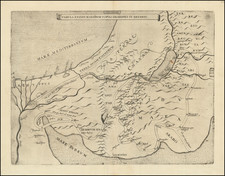
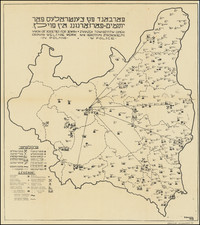
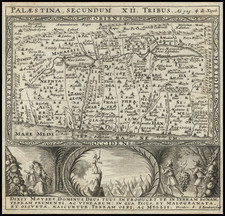
![(Yom Kippur War Aftermath) Rozmieszczenie posterunkow w strefie buforowej [Placement of Outposts in the Buffer Zone] | Egypt 1:100,000 (Port Said, El-Tina Bay, Sabkhet El-Bardawil)](https://storage.googleapis.com/raremaps/img/small/96264.jpg)
